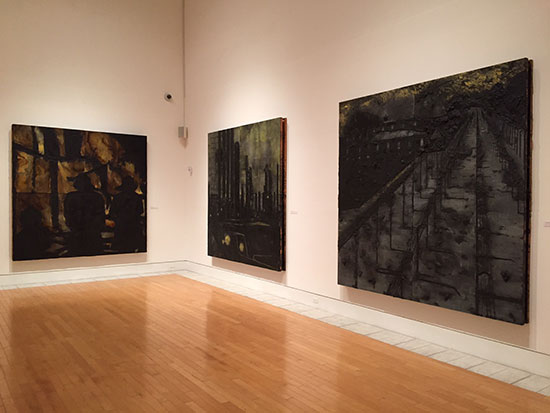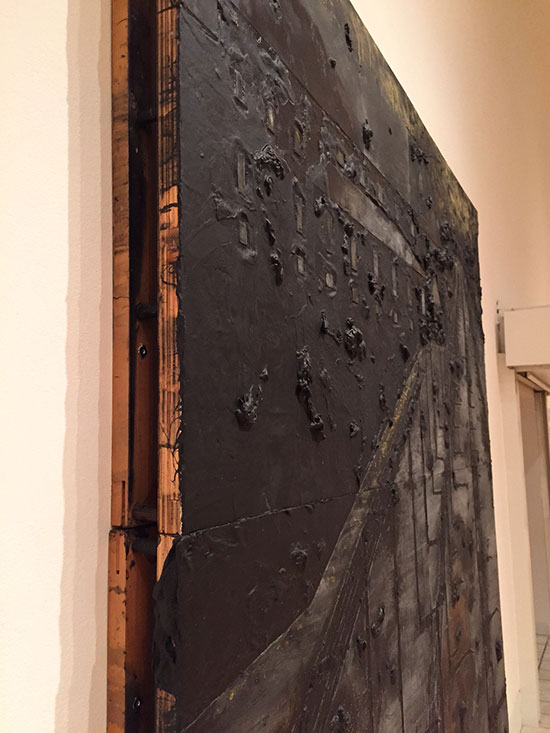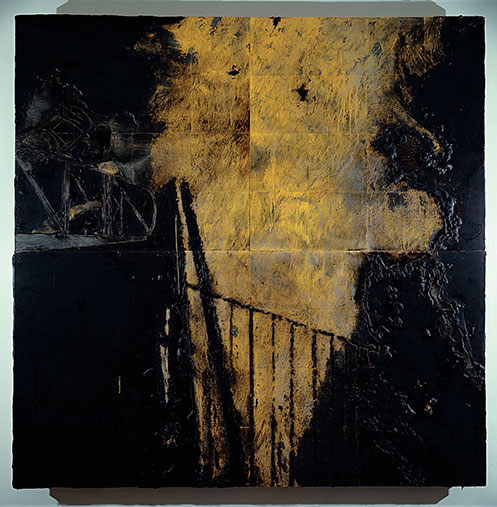Painter Donald Sultan is known for his bright graphic paintings of poppies, lemons and tulips. These paintings sent his art star shooting high quickly in the late 1970s in New York, with shows at Artists Space, Mary Boone and the Whitney Biennial, all within three years.
While the pop-colored, large scale work was an early calling card, he was also working on a darker series that is just now getting its due. “The Disaster Paintings,” made from 1984 to 1990, is a visceral, hulking, massive series that echoes Anselm Keifer’s grand dark Germanic fields and Jack Goldstein’s stark explosion paintings: in the works’ large scale, industrial materials and dark depictions of what the artist has called “the death of architecture, the impermanence of everything.”
A traveling show of 10 of the paintings in this series is on view at the Lowe Art Museum in Coral Gables, Florida, through December 23, 2016 and will go on to the Smithsonian Museum of American Art in Washington, D.C.; the Fort Worth Museum of Modern Art in Texas—which organized the exhibition; the North Carolina Museum of Art in Raleigh; and the Sheldon Museum of Art in Lincoln, Nebraska.
.

"Donald Sultan: The Disaster Paintings" on view at the Lowe Art Museum in Coral Gables, Florida, through December 23, 2016.
.
The Lowe Museum exhibition of “Donald Sultan: The Disaster Paintings” is being presented with support from the Robert Lehman Foundation. The works on view come from private collections and such museums as the Parrish Art Museum in Water Mill; the Dallas Museum of Art; and the Museum of Fine Arts in Boston, among others.
.

"Polish Landscape II Jan 5 1990 (Auschwitz)" by Donald Sultan, 1990. Latex and tar on tile over Masonite, 96 × 96 inches. The Parrish Art Museum, Water Mill, New York. Gift of The Broad Art Foundation.
.
Some of the works could arguably be termed sculptures based on their three-dimensionality, as they are made of Masonite covered with vinyl tiles gouged out and “painted” with tar. The tiles are laid on huge (typically 8- by 8-foot) sheets of Masonite mounted on another double layer of wood and short metal rods that push the work several inches out from the wall. The smoldering scenes are of fires, explosions, devastation and industrial and urban calamities.
.

Side view of a disaster painting by Donald Sultan.
.
Sultan has never shown the “Disaster” paintings together as a group. Between 1984 and 1990, he painted catastrophic events that he saw in the newspapers. But he wasn’t really interested in the disaster itself but rather the aftermath, after the fire, flood, or explosion. He particularly was drawn to those types of events that are not witnessed as they occur, with the havoc wrought revealing itself as a whimper and not a bang.
At a gallery talk at the show’s opening on September 29, 2016 Sultan said, “The destruction depicted in them was mostly caused by unknowable or unseeable things. You don’t see the actual executioner; like shelling from artilleries 100 miles away. The destruction of the earth by oil rigs and refineries. And the poisoning of the waters. So you don’t see the direct result of the event but the fallout from the carrying of the wind.”
The paintings are as far from his yellow and black, flat graphic fruit and flower works as you can get. They are gorgeously dark, foreboding, and apocalyptic; the room where they are hung at the Lowe feels like a window into a netherworld. The disaster paintings also veer into abstraction, an approach that continues to interest Sultan in his work today.
.

"Early Morning May 20" by Donald Sultan. Latex and tar on tile over Masonite. Courtesy of the Lowe Art Museum.
.
Sultan, now in his mid-60s, was named one of the “art stars” of the 1980s, alongside such artists as Basquiat, Haring, Schnabel, Fischl, Salle and others. He painted large and shared the zeitgeist of those who blurred the lines—of what paintings were and what painting could do—by using found materials and in-your-face imagery. But Sultan left Mary Boone’s stable for uptown dealers he felt had better artists at the time, and was left out of much of the “Painters School” publicity and sales excitement Boone soon created.
“I’ve always thought of [my paintings] as stages,” the artist said during his talk at the opening. “My big book is called ‘The Theater of the Object.’ It asks, ‘What is the drama around the painting?’ The thing about painting, though, is it doesn’t tell you the story right away. It’s not like there is a beginning, middle and end. You, as a viewer, become a part of the its finish. What I liked about it was it was about American everyday work.
“Abstract Expressionists weren’t dandies, they were real people, blue collar almost,” Sultan said. “Arte Povera artists weren’t like that but they valued simplicity in materials. I used them economically. I could buy tar at hardware stores and didn’t need to build a huge supply of oil paints. I figured: paint, tar, it’s all manufactured anyways.”
“I like the strength of the material,” he continued. “Pushing it is a wonderful feeling. They sometimes change the materials within the tar, so the paintings change with the material.”
In “The Disaster Paintings” (Prestel Publishing), a beautifully done book created to accompany the exhibition, Sultan explains the story of each painting. His words illuminate—perhaps too much—the thought process and image that went into each work.
In the book he writes: “In the paintings I start with newspaper photos, then I add more layers, such as the surface of the paintings or panels, which makes it all harder to decipher. I wanted the works to be like that – to mirror how in an actual event it’s hard to fully grasp what’s happening. Imagination is more powerful than action.”
.

"Southend Feb 24" by Donald Sultan. Latex and tar on tile over Masonite. Courtesy of the Lowe Art Museum.
.
On why he stopped making them in 1990 he says “I had made a lot of them and I just didn’t feel like continuing. The events of the day had caught up with me. Now every day there’s a new catastrophe. So they don’t need me. I’ve got nothing to say about that. It’s a lot easier to destroy than build. That’s what the work talks about – life and death.”
It’s a phenomenal body of work, literally ripped from the loft floor where he lived and worked in the ’80s as well as from newspaper headlines. You feel the grime and despair and helplessness as unseen objects burn and lives are changed in an instant. These paintings capture the dark fascination with the chaos of the industrial world.
.

"Accident" by Donald Sultan. Latex and tar on tile over Masonite. Courtesy of the Lowe Art Museum.
.
Donald Sultan is based in New York City and Sag Harbor, N.Y. in The Hamptons.
_______________________________
BASIC FACTS: “Donald Sultan: The Disaster Paintings” remains on view through December 23, 2016 at Lowe Art Museum, University of Miami, 1301 Stanford Drive, Coral Gables, FL. www.lowemuseum.org.
________________________________
Copyright 2016 Hamptons Art Hub LLC. All rights reserved.

These dark paintings as seen here online give me a strange comfort — the comfort of ‘awareness’ as in ‘eyes open.’ It really doesn’t matter ‘when’ they were painted. I wish they were coming to New York in the flesh. They have a ‘pull’ like molasses.